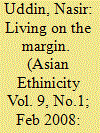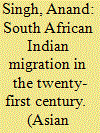|
|
|
Sort Order |
|
|
|
Items / Page
|
|
|
|
|
|
|
| Srl | Item |
| 1 |
ID:
080621


|
|
|
|
|
| Publication |
2008.
|
| Summary/Abstract |
With national security concerns dominating the agenda for many states and with the management of cultural diversity under close scrutiny, can the agenda of multiculturalism - with its desire to accommodate cultural differences - survive? By assessing Singapore's review of its multiculturalism policy in this 'age of terror', this paper argues that the project of multiculturalism is far from over. Moreover, it argues that, if performed well and permitted to evolve constantly, multiculturalism may instead be a bulwark against the allure of what has become termed 'home-grown' terrorism. The argument progresses in broadly three parts. The first part defines the terms multicultural and multiculturalism, and presents a continuum of different approaches to multiculturalism. This section is keen to stress the diversity present in policies of multiculturalism in order to highlight the different policy options available to the management of difference. In the second part, Singapore's policy of multiculturalism is located on the continuum and assessed. Finally, by tracing recent alterations to Singaporean multiculturalism, the final part of the paper suggests possible adaptations that may be required of plural societies when (en)countering extremist ideology.
|
|
|
|
|
|
|
|
|
|
|
|
|
|
|
|
| 2 |
ID:
080622


|
|
|
|
|
| Publication |
2008.
|
| Summary/Abstract |
The Chittagong Hill Tracts (CHT) of Bangladesh has long been represented as a region of multi-ethnic setting, ethnic conflict and ethnic movement in South Asia. However, inter-ethnic relationship through the practice of unequal power and positions among the 'Pahari' (hill-people), the inhabitants of the CHT, has largely been ignored in the deeper understanding of the CHT. In addition, available CHT literature talks mostly about numerically dominant ethnic groups, whereas less attention is paid to the marginalized 'Pahari' ethnic groups. This paper examines the positioning of the 'Khumi', one of marginalized Pahari ethnic groups, within the larger canvas of CHT vs state across times and regimes. In an attempt to identify the position of the Khumi within the sociopolitical and ethnic history of the CHT, it seeks answers to three central questions: (a) How did the Khumi appear in the demographic configuration of the CHT? (b) How had they, along with the CHT and its other inhabitants, been dealt with during the colonial and postcolonial regimes? (c) How do they position themselves in the recurrent sociopolitical dynamics of CHT vs state relationship? The paper is based on critical consideration of secondary sources on the region in collaboration with relevant comprehensive data collected through ethnographic fieldwork undertaken from November 2005 to April 2007 in the CHT of Bangladesh
|
|
|
|
|
|
|
|
|
|
|
|
|
|
|
|
| 3 |
ID:
080620


|
|
|
|
|
| Publication |
2008.
|
| Summary/Abstract |
This paper is inspired by three issues, namely ongoing research on South Africans of Indian origin, the anecdotal evidence that accumulates through ongoing discussions on a casual level with such people and the increasing interest among researchers about how globalization and transnational movements are impacting upon identity formation among minorities who are seeking employment or a new life in the developed economies of the 'big five' English-speaking countries, i.e. the USA, Canada, Australia, New Zealand and the UK. It is in countries such as these that a third identity emerges and develops to instill a sense of triple identity. The information here suggests that, when people of Indian origin migrate to one of these countries, they continue to cling to South Africa because it is their country of birth, as well as to India, more for sentimental rather than practical reasons. The topic of this paper reflects a contemporary phenomenon not just among the Indians in South Africa, but also among other diasporas such as Chinese in Latin America, whose new and final emigration destination always seems to be the US. In addition, people of Chinese origin in the countries of Indochina, such as Vietnam, Laos and Cambodia, experienced similar patterns of becoming diasporas in Europe, North America and Oceania in the 1970s. However, migration implores them to renegotiate their identities in order to adapt and settle in accordance with their newly adopted host territories. This gives rise to an identity that straddles three countries, which induces the need to examine new ways of identity building in a global transnational economy.
|
|
|
|
|
|
|
|
|
|
|
|
|
|
|
|
| 4 |
ID:
080623


|
|
|
|
|
| Publication |
2008.
|
| Summary/Abstract |
Ethnic Koreans in China have been widely recognized as a 'model minority' primarily for academic success. Using the data collected as part of a larger ethnographic research on Korean elementary school students, this paper examines how 27 Korean families construct meaning out of the model minority stereotype in the context of their lived experience in Northeast China. Research results indicate that Koreans constructed the multi-faceted nature of 'model minority' as a matter of cultural superiority and dual economic marginalization in the Chinese and South Korean mainstream societies, and valued education as a practical means to achieve economic upward mobility into the Chinese mainstream. This paper argues that the model minority stereotype with the cultural explanations for Korean success may reinforce the cultural deficiency argument about the academic failure of 'backward' minorities, silence the disadvantages suffered by Koreans in China's reform period and lead to no active intervention to remedy them
|
|
|
|
|
|
|
|
|
|
|
|
|
|
|
|
|
|
|
|
|